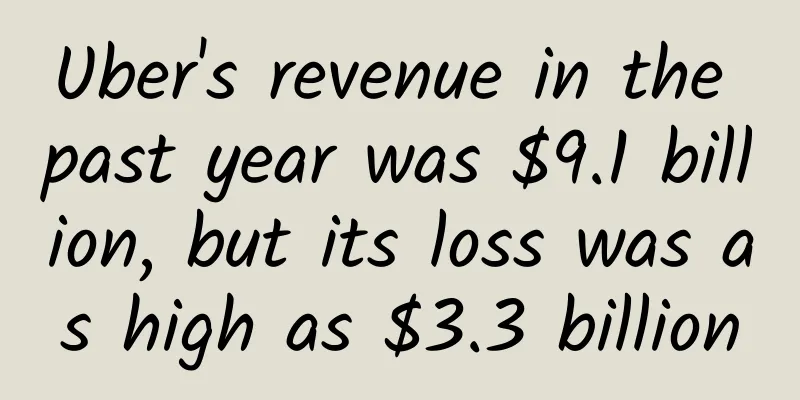Uber's revenue in the past year was $9.1 billion, but its loss was as high as $3.3 billion

|
According to the Financial Times on June 25, Beijing time, the turmoil at Uber, a ride-hailing app, has made its next CEO face a greater challenge in solving a major company problem: how to make the ride-hailing business truly profitable. Uber is the most loss-making private company in the history of the technology industry, and its next CEO will be under pressure to increase efforts to reduce losses. In the past four quarters, excluding interest, taxes and equity incentive expenses, Uber's operating losses exceeded $3.3 billion, a figure far exceeding other companies such as Amazon that often lose money. In Uber's view, ride-hailing is a commodity, and the company's goal is to become the largest and lowest-cost provider of this commodity. To achieve this goal, Uber first focused on expanding the market and injecting a lot of capital into the market to attract passengers and drivers. This strategy has been successful and helped Uber achieve huge growth: in the first quarter of this year, Uber's revenue was $3.4 billion, three times that of the same period last year. Operating losses of $3.3 billion in the past year In the past four quarters, Uber's revenue was $9.1 billion, which is more than Twitter or Tesla's revenue. Last year, investors valued Uber at $62.5 billion. Figure 2: Uber's revenue and losses However, the challenge Uber now faces is how to transform a business model that has been very successful in revenue growth into a business model that is more economically sustainable and ultimately profitable. Some economists say Uber has no good way to do this, even before the latest challenge. After a series of scandals, including the resignation of CEO Travis Kalanick, Uber now faces the challenge of rebuilding its top management and getting out of the shadow of scandal. "I don't see a clear path for Uber to transform from a high-revenue growth company to a profitable company," said Aswath Damodaran, a professor of finance at New York University's Stern School of Business. "The normal development model of a startup is that as revenue grows, economies of scale will emerge, but Uber is not that type of startup." Moreover, the leadership vacancy has also called into question one of Uber's main advantages: raising large amounts of money at low cost. Uber currently has $6.5 billion to $7 billion in unrestricted cash in the bank and $2.3 billion in unused credit lines. Based on Uber's losses in the first quarter of this year, these funds should be enough to meet Uber's funding needs for the next three years. Whether Uber can embark on a sustainable path will depend on controlling two major costs: subsidies to passengers and drivers, and general costs such as engineering and research and development. As Uber grows, the company's recurring expenses calculated on a per-ride basis have fallen, thanks to economies of scale. Figure 3: Lyft eats into Uber's US share Subsidies are essential because Uber uses them to maintain a two-sided travel market and balance the supply and demand of drivers and passengers. Sign-on bonuses can attract new drivers and maintain a sufficient driver pool. At the same time, Uber's more specific bonuses for special times and places help attract drivers to provide services in high-demand areas. Even in the United States, Uber's largest and longest-established market, Uber is not profitable, partly because it has to fight off a new round of attacks launched by its main rival Lyft. Lyft's attacks have continued this year, and the company has also benefited from the "Delete Uber App" campaign. Data from market research firm Second Measure show that as of the end of May, Uber's US market share had fallen from 84% at the beginning of the year to 77%. Uber has had a hard time defending its market dominance because it’s so cheap for passengers and drivers to switch to ride-hailing apps. However, Uber has been successful in narrowing its global operating losses, reporting $708 million in the first quarter of this year, down from $990 million in the previous quarter. Subscription Model Uber and Lyft are also experimenting with different revenue models in one area: subscriptions, which offer “monthly” memberships to passengers who frequently take rides. For example, a passenger could pay $20 a month to take 20 rides at $2 each. This subscription model could make sense given that Uber and Lyft want more city dwellers to give up their cars and switch to their services, especially in cities that lack robust public transportation. Figure 4: Uber's Funding and Valuation "Subscription models are always very beneficial," said Santosh Rao, head of research at Manhattan Venture Partners. "You can see that this is a good recurring revenue model. If they can build that model, it will be very beneficial." Mitchell Green, an Uber investor and partner at private equity firm Lead Edge Capital, believes that the ride-hailing market will continue to grow, which will benefit both Uber and Lyft. Earlier this week, Uber CEO Travis Kalanick was ousted by a group of investors who wanted the company to go public. "New management means that Uber's big IPO may be a little earlier than we expected before Travis left," said Rohit Kulkarni, managing director of private equity trading website SharesPost. As Uber's new CEO copes with the changing ride-hailing app market, he must also ensure that Uber does not disappoint investors. Uber's $62.5 billion valuation is closely related to the question of how ride-hailing apps can achieve profitability. As a winner of Toutiao's Qingyun Plan and Baijiahao's Bai+ Plan, the 2019 Baidu Digital Author of the Year, the Baijiahao's Most Popular Author in the Technology Field, the 2019 Sogou Technology and Culture Author, and the 2021 Baijiahao Quarterly Influential Creator, he has won many awards, including the 2013 Sohu Best Industry Media Person, the 2015 China New Media Entrepreneurship Competition Beijing Third Place, the 2015 Guangmang Experience Award, the 2015 China New Media Entrepreneurship Competition Finals Third Place, and the 2018 Baidu Dynamic Annual Powerful Celebrity. |
<<: Meizu feels so wronged, Samsung stops selling 8895 chips, Meizu is suddenly confused
Recommend
Beware! Falling has become the number one killer of the elderly. How to prevent it is the key?
Elderly falls, a seemingly trivial matter, actual...
It’s the last day of the first lunar month, and I can finally get a haircut?
Mixed Knowledge Specially designed to cure confus...
Let’s breathe in the forest and explore the natural treasures of Gaoligong Mountain
Get to know Gaoligong Mountain Gaoligong Mountain...
On the surface, everything seems calm, but secretly he is going crazy! Who is keeping his emotions stable?
“Be an emotionally stable person” Gradually becom...
Convincing "deep fakes" just to make you smile?
Leviathan Press: I personally think Walter Schere...
Tailing's "I'm Open-Minded" theme event invites you to immerse yourself in stress relief and have fun with Tailing
On September 23, 2023, the 19th Asian Games opene...
Protecting the river beach! The "amphibious guards" that are not afraid of flooding have "settled down" on both sides of the Yangtze River
The model species of the sparse-flowered water cy...
China Association of Automobile Manufacturers: China's new energy vehicle market fell by about 4.0% in 2019
According to the China Association of Automobile ...
5 tips to improve your YouTube search ranking!
We will introduce some methods to improve the fac...
Apache Wicket 6.21.0 released, web development framework
Apache Wicket 6.21.0 released. Wicket is now deve...
What kind of methodology can continuously create popular marketing products?
For most marketers, screen swiping is something t...
Case practice: How can lottery activities attract users?
Last night, there was a very interesting discussi...
How to carry out promotion operations? Share 10 tips!
The era of the entire network has arrived, and on...
A must-have for operations, promotion and marketing: a complete list of the latest hot topics in July 2017!
Nowadays, chasing hot topics has become one of th...









